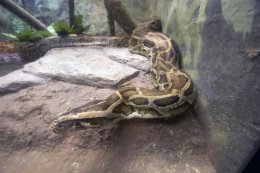Burmese python Lifespan

Python molurus bivittatus
Burmese pythons inhabit grasslands, swamps, marshes, rocky foothills, woodlands, jungle and river valleys in Northeast India, Myanmar, Thailand, Laos, Cambodia, Vietnam, Nepal, Bangladesh, northern continental Malaysia and western Indonesia through southern China. They are carnivores.
Burmese pythons have been introduced into the Everglades in South Florida. Many were pets accidentally released or intentionally abandoned when they grew too big. In the wild, they are proliferating; preying on and competing with native species, some as large as alligators. Biologists are working to remove them via radio tracking, locator dogs and hunting.
Burmese python behavior and facts
- Like all pythons, Burmese pythons are nonvenomous.
- They can climb or swim as they prey on rodents, mammals, birds and other reptiles.
- They use rear-pointing teeth to seize prey and then wrap their body around it, killing by constriction.
- They are mainly terrestrial and are active both in the evening and at night.
- They require a permanent source of water.
From birth to death
- Females typically lay between 1 to 2 dozen eggs in a clutch.
- The female incubates the eggs by coiling atop them.
- Gestation: 60 to 90 days
- Hatchlings: 18 to 24 inches.
- Babies leave the nest soon after hatching and grow quickly when food is abundant.
- Sexual maturity is size- rather than age-based but generally occurs around 4 years of age.
- Lifespan: 15 to 25 years
Vital statistics
- Up to 25 feet long
- 200 or more pounds
Status
CITES Appendix II
Did you know?
Burmese pythons, like many other reptiles, keep growing their entire life. Many start in the pet trade as small snakes two to three feet long. In several years they may grow to more than 15 feet long and weigh more than 100 pounds.
You might also like




|
apr_612_2 Snakes - Burmese Python - Aprons - Medium Length Apron with Pouch Pockets 22w x 24l Home (3dRose LLC)
|









